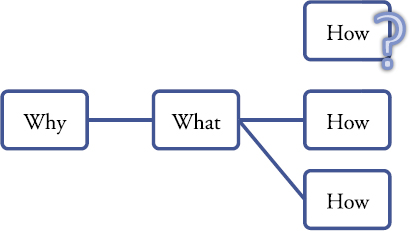Finding the “How”
You know “Why” you want to make the change, and you know “What” to change, now, you need to focus on “How” that change will come about, and answer the question, “What steps will we take in order to close the gap between where we are and where we should be?” This answer may require some detailed analysis.
You may already have your answer. Take a moment now to bring together all the content you have that describes how your change will happen. This content can include strategies, project plans, sets of activities, and to-do lists. You cannot share all of the details in most visual stories, but you will need some details to start with and a good reason to believe that you know, at a minimum, how all the changes will be made.

Every activity you identify in this chapter should link to a “What” you identified in the last chapter. If you can't find a “What” for an activity, but you do have a “Why” you want to link it to, go back a step and work out the “What” that should be there! Often this happens because the “What” does not exist yet, and your activity may be creating it for the first time.
Many people with a story to tell are intelligent, thoughtful, and ineffective. One of the most difficult, but important, parts of a visual story is the focus on key elements that need to change. This focus can turn an ineffective story into one with real impact. At the start ...
Get Stories that Move Mountains: Storytelling and Visual Design for Persuasive Presentations now with the O’Reilly learning platform.
O’Reilly members experience books, live events, courses curated by job role, and more from O’Reilly and nearly 200 top publishers.

